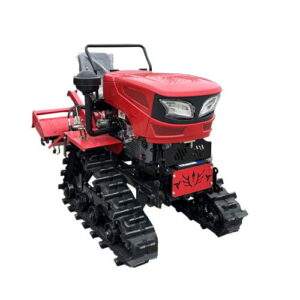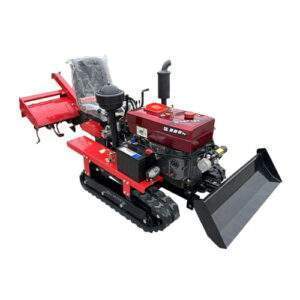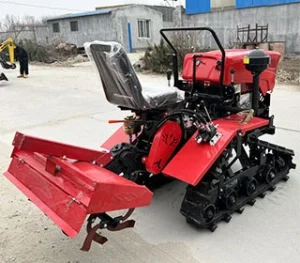How Crawler Tractors Improve Efficiency on Job Sites
Welcome to My Blog!
Before we dive into the content, I’d love for you to join me on my social media platforms where I share more insights, engage with the community, and post updates. Here’s how you can connect with me:
Facebook:https://www.facebook.com/profile.php?id=61557298070472
Now, let’s get started on our journey together. I hope you find the content here insightful, engaging, and valuable.
Introduction

In the ever-evolving world of construction and heavy machinery, crawler tractors have emerged as vital tools that significantly enhance efficiency on job sites. These robust machines are designed to tackle a range of tasks, from earthmoving to site preparation, making them indispensable in modern construction projects. This blog will explore the multifaceted ways in which crawler tractors improve operational efficiency, their key features, and their applications across various industries.
What Are Crawler Tractors?
Crawler tractors are heavy-duty machines equipped with continuous tracks rather than wheels. These tracks provide superior traction and stability, especially in challenging terrains such as muddy or uneven ground. Unlike wheeled tractors, crawler tractors distribute their weight more evenly, reducing soil compaction and preventing damage to delicate surfaces. This makes them ideal for a variety of construction and agricultural applications.
Key Components
- Tracks: Continuous tracks provide enhanced stability and traction.
- Caterpillar Wheels: These distribute the machine’s weight evenly to prevent soil compaction.
- Hydraulic System: Controls various functions such as lifting and tilting.
- Engine: Powers the tractor and determines its operational efficiency.
How Crawler Tractors Enhance Efficiency
Superior Traction and Stability
Crawler tractors excel in providing superior traction and stability compared to wheeled vehicles. The large, continuous tracks ensure that the machine remains stable even on loose or uneven terrain. This is particularly beneficial in muddy conditions or on slopes where traditional wheeled vehicles may struggle.
Benefits:
- Reduced Slippage: Enhanced grip on slippery or loose surfaces.
- Increased Load-Carrying Capacity: Ability to handle heavier loads without tipping.
- Improved Safety: Lower risk of accidents due to better stability.
Reduced Soil Compaction
One of the significant advantages of crawler tractors is their ability to reduce soil compaction. The wide tracks distribute the machine’s weight over a larger area, minimizing the pressure exerted on the ground. This helps preserve soil quality and improves the effectiveness of subsequent construction or agricultural activities.
Benefits:
- Improved Soil Health: Less compaction leads to better soil aeration and drainage.
- Enhanced Agricultural Productivity: Healthier soil supports more robust crop growth.
- Reduced Surface Damage: Minimizes disruption to existing structures or landscaping.
Versatility in Application
Crawler tractors are highly versatile and can be adapted for a wide range of tasks. They are commonly used for earthmoving, grading, and land clearing, but their versatility extends to other applications such as construction, forestry, and mining.
Applications:
- Earthmoving: Excavation and movement of soil or rock.
- Grading: Leveling and smoothing surfaces for construction.
- Land Clearing: Removing vegetation and debris.
- Forestry: Handling logs and clearing forested areas.
Increased Productivity Through Advanced Features
Modern crawler tractors are equipped with advanced features that enhance their productivity. Technologies such as GPS, automated controls, and sophisticated hydraulic systems allow for more precise and efficient operation. These innovations contribute to faster completion times and higher quality results.
Features:
- GPS Integration: Enables accurate site mapping and machine positioning.
- Automated Controls: Simplifies operation and improves precision.
- Advanced Hydraulics: Enhances lifting, digging, and grading capabilities.
Applications of Crawler Tractors on Job Sites
Construction Projects
In construction, crawler tractors play a crucial role in site preparation, excavation, and grading. They are used to clear land, dig foundations, and move materials, making them essential for both residential and commercial construction projects.
Benefits:
- Efficient Site Preparation: Quick and effective land clearing and leveling.
- Enhanced Digging Capabilities: Capable of handling tough soil and rock.
- Streamlined Material Movement: Effective in transporting heavy materials across the site.
Agricultural Operations
In agriculture, crawler tractors are used for tasks such as plowing, tilling, and planting. Their ability to handle rough terrain and reduce soil compaction makes them ideal for large-scale farming operations.
Benefits:
- Improved Soil Tillage: Efficiently prepares soil for planting.
- Reduced Soil Compaction: Maintains soil health for better crop yields.
- Versatile Farming Applications: Suitable for various agricultural tasks.
Forestry and Land Management
Crawler tractors are also valuable in forestry and land management for clearing trees, transporting logs, and preparing land for new uses. Their durability and ability to work in challenging conditions make them well-suited for these applications.
Benefits:
- Effective Tree Removal: Handles large trees and dense vegetation.
- Efficient Log Transport: Moves heavy logs with ease.
- Land Preparation: Prepares land for reforestation or other uses.
Mining and Quarrying
In mining and quarrying, crawler tractors are used for tasks such as stripping overburden, moving ore, and managing waste. Their strength and stability are crucial for operating in rugged and demanding environments.
Benefits:
- Robust Performance: Capable of withstanding harsh conditions.
- Efficient Overburden Removal: Speeds up the mining process.
- Effective Waste Management: Manages mining by-products and debris.
Comparative Analysis of Crawler Tractors and Wheeled Tractors
While crawler tractors offer numerous advantages, it’s helpful to compare them with wheeled tractors to understand their relative strengths.
| Feature | Crawler Tractors | Wheeled Tractors |
|---|---|---|
| Traction | Superior on uneven or soft terrain | Better on hard, flat surfaces |
| Soil Compaction | Lower due to wide tracks | Higher due to concentrated weight |
| Stability | High, especially on slopes or unstable ground | Moderate, less effective on slopes |
| Versatility | High, with various attachments and applications | Moderate, typically more specialized |
| Operational Speed | Generally slower due to heavy tracks | Faster on flat surfaces |
Maintenance and Care for Crawler Tractors

Routine Inspections
Regular inspections are vital to ensure the crawler tractor remains in optimal working condition. This includes checking the tracks, hydraulic system, and engine for any signs of wear or damage.
Checklist:
- Track Condition: Inspect for cracks or wear.
- Hydraulic Fluids: Check levels and quality.
- Engine Performance: Monitor for any irregularities.
Track Maintenance
The tracks of a crawler tractor are critical for its performance. Regular maintenance includes cleaning, adjusting tension, and replacing worn tracks to ensure smooth operation.
Maintenance Tips:
- Clean Tracks Regularly: Remove dirt and debris.
- Adjust Tension: Ensure proper track tension for optimal performance.
- Replace Worn Tracks: Address track wear promptly to prevent operational issues.
Hydraulic System Care
The hydraulic system is essential for many of the tractor’s functions. Regularly check hydraulic fluids, inspect hoses for leaks, and ensure that hydraulic components are functioning correctly.
Maintenance Tips:
- Monitor Fluid Levels: Keep hydraulic fluids at the recommended levels.
- Inspect Hoses: Look for signs of wear or leakage.
- Check for Leaks: Address any hydraulic leaks immediately.
Conclusion
Crawler tractors are invaluable assets on job sites, offering unmatched traction, stability, and versatility. Their ability to handle a variety of tasks efficiently makes them essential in construction, agriculture, forestry, and mining. By reducing soil compaction, increasing productivity, and providing superior performance in challenging conditions, crawler tractors significantly enhance the efficiency of operations. Proper maintenance and understanding of their features further ensure that these machines continue to perform at their best, contributing to successful and timely project completion.
FAQ
What are the primary advantages of using crawler tractors over wheeled tractors?
Crawler tractors offer superior traction and stability on uneven or soft terrain, reduced soil compaction, and increased load-carrying capacity. They are particularly effective in challenging conditions where wheeled tractors may struggle.
How does soil compaction affect construction and agricultural projects?
Soil compaction can negatively impact construction projects by creating uneven surfaces and increasing the risk of structural issues. In agriculture, it can hinder root growth and reduce crop yields. Crawler tractors help mitigate these issues by distributing weight more evenly.
What types of tasks can crawler tractors perform?
Crawler tractors are versatile machines capable of performing tasks such as earthmoving, grading, land clearing, plowing, tilling, and more. They are used across various industries, including construction, agriculture, forestry, and mining.
How often should crawler tractors be inspected and maintained?
Routine inspections should be conducted regularly, typically every 50-100 hours of operation or according to the manufacturer’s guidelines. Regular maintenance includes checking tracks, hydraulic systems, and engine performance to ensure optimal operation.
Are crawler tractors suitable for all types of terrain?
Crawler tractors are well-suited for uneven, soft, or challenging terrain where wheeled tractors might struggle. However, they may not be as efficient on flat, hard surfaces where wheeled tractors excel.



